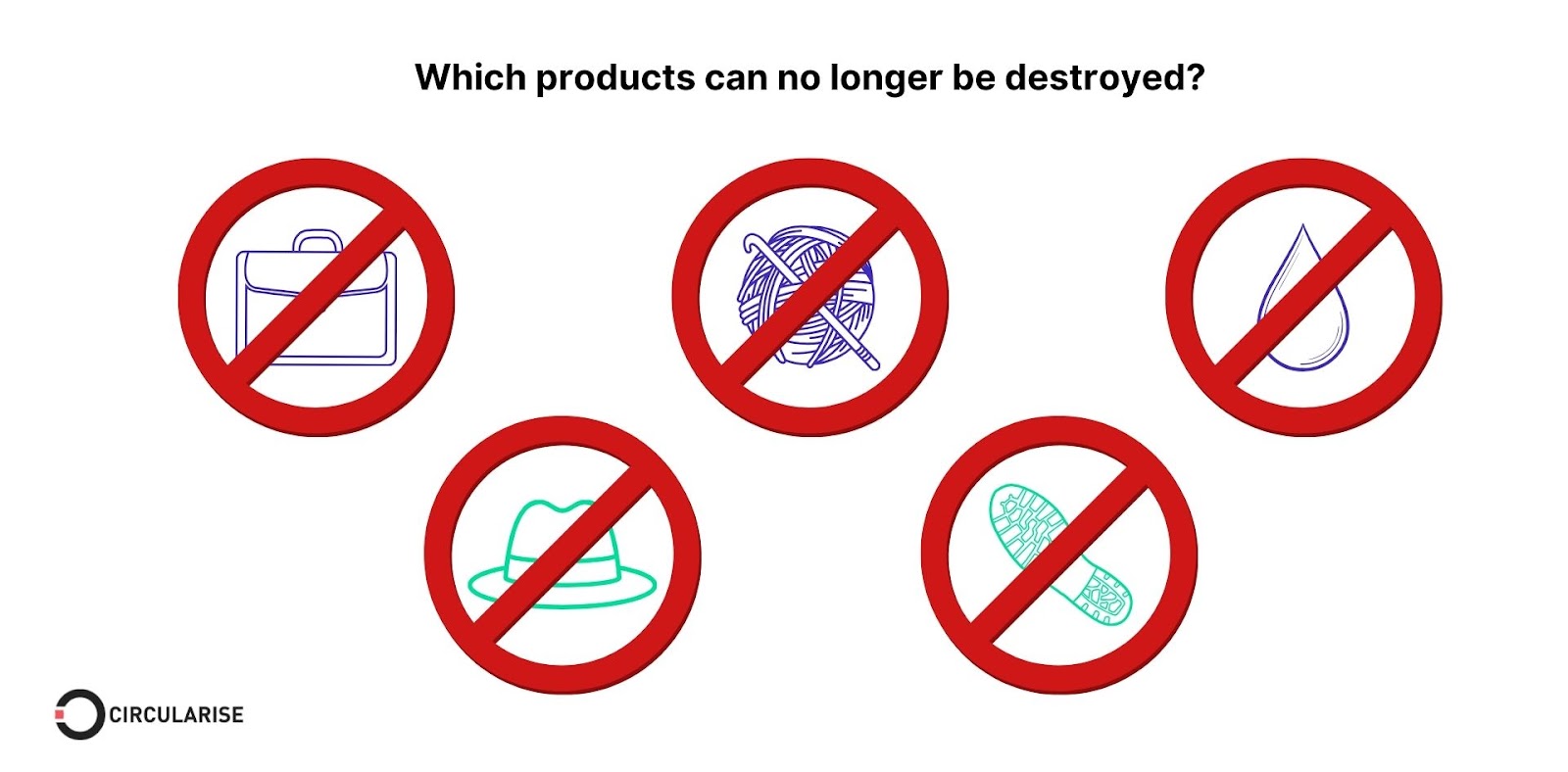This is Part 3 of the series "Get Ready for ESPR: Shaping the Future of Sustainable Business."
This article dives into the rules around the discarding and destruction of unsold products under the Ecodesign for Sustainable Products Regulation (ESPR). As part of the EU’s ongoing sustainability efforts, businesses are encouraged to shift away from wasteful destruction practices and instead prioritise circular economy strategies such as reusing, refurbishing, or donating unsold goods. We will also examine the upcoming regulations on product destruction and the steps businesses can take to comply, reduce environmental impact, and foster a circular economy.
What are the ESPR rules on discarding products?
Under the ESPR, businesses must focus on reuse, refurbishment, or donation of unsold products rather than discarding them. If a business does discard products, it must provide detailed information about the discarded items, including:
1. Amount and weight
Businesses must report the number and weight of discarded products.
2. Reason for discarding
The reason for discarding the products should be clearly stated (e.g., unsold, damaged, outdated).
3. Handling of discarded products
Information on how the discarded products are being handled, including:
- The proportion that is being reused, refurbished, remanufactured, recycled, or used for energy recovery.
- Any efforts to prevent the destruction of unsold products, including reuse or donation initiatives.
4. Public disclosure
This information must be made publicly available on the company’s website and included in its annual sustainability report.
Businesses must ensure that the information is transparent and accessible. Medium-sized enterprises are required to comply with these disclosure requirements by 19 July 2030. While micro and small enterprises are currently exempt, they are encouraged to already adopt sustainable practices.
It is important to know that the European Commission or national authorities may request further documentation regarding the handling of discarded products. Businesses must provide this documentation within 30 days of the request. The appropriate formats for disclosure will be provided by the European Commission on 19 July 2025.
What are the ESPR rules on the destruction of products?
The ESPR prohibits the destruction of certain unsold products starting 19 July 2026, with specific rules applying to apparel and footwear. This prohibition aims to reduce waste and encourage the donation, reuse, or recycling of unsold goods.

The affected products include the following:
Apparel and clothing accessories 👕
- Made of leather or composition leather
- Knitted or crocheted
- Hats and other headgear, including those made of textile materials or lace
Footwear 👟
- Made with outer soles of rubber, plastics, leather, or composition leather
- Waterproof footwear
- Other footwear made with rubber, plastics, leather, or textile materials
These rules apply to medium-sized enterprises from 19 July 2030. Micro and small enterprises are exempt for now but are still encouraged to avoid destroying products.
Exemptions to the Destruction Ban
There are several exemptions to the destruction ban, including:
- Health, hygiene, or safety reasons: Products that cannot be used safely due to health or hygiene concerns.
- Damage beyond repair: Products that are so damaged they cannot be repaired cost-effectively.
- Legally or technically unfit for use: Products that are legally or technically unfit for their intended use.
- Donations that were not accepted: Products that have been offered for donation but were not accepted.
- Unfit for reuse or refurbished: Products that cannot be refurbished or reused.
- Intellectual property violations: Counterfeit or pirated products.
- Environmental impact: If destruction is deemed to have the least environmental impact, for example, due to the inability to recycle the product.
The European Commission may also add other exemptions by 19 July 2025.
Prepare for ESPR compliance now
To comply with ESPR rules on discarding and destruction of products, businesses should take proactive steps:
- Track unsold products:
- Implement traceability systems to track unsold products, including their number, weight, and reason for discarding.
- Reuse and donate: Prioritise reuse, refurbishment, and donation of unsold products instead of destruction. Ensure that the proper processes are in place to handle products in these ways.
- Establish transparency: Publicly disclose the information about discarded products on your website and in your sustainability reports. Ensure that all required data is available to stakeholders.
- Prepare for future reporting: Get ready for the European Commission to request further documentation on discarded products in 2026 and 2030, and ensure that the required formats for reporting are followed.
By adopting these measures now, businesses can stay ahead of ESPR requirements and contribute to reducing waste while promoting circularity in their operations.
Sustainable product disposal for ESPR compliance
By prioritising reuse, refurbishment, and donation over destruction, businesses can reduce waste, align with EU sustainability goals, and foster circularity. The ESPR encourages businesses to adopt sustainable practices in product disposal and to provide transparency in handling discarded products. As the regulations evolve, businesses must stay proactive in meeting compliance requirements to minimise environmental impact and contribute to a more sustainable economy.
In Part 4, we’ll show you how digital product passports (DPPs) enhance traceability and transparency, and how they can support your sustainability goals.
📚 Explore the series at your own pace.
Part 1: What you need to know about ESPR
Part 2: Horizontal rules under ESPR
Part 4: ESPR enhances traceability and transparency with digital product passports
Part 5: Specific ESPR requirements for manufacturers, importers, distributors, and retailers
Part 6: Why stakeholder collaboration matters for ESPR compliance
Part 7: Turning compliance challenges into opportunities with ESPR

Circularise is the leading software platform that provides end-to-end traceability for complex industrial supply chains. We offer two traceability solutions: MassBalancer to automate mass balance bookkeeping and Digital Product Passports for end-to-end batch traceability.
Would you prefer to have this delivered straight to your inbox?








